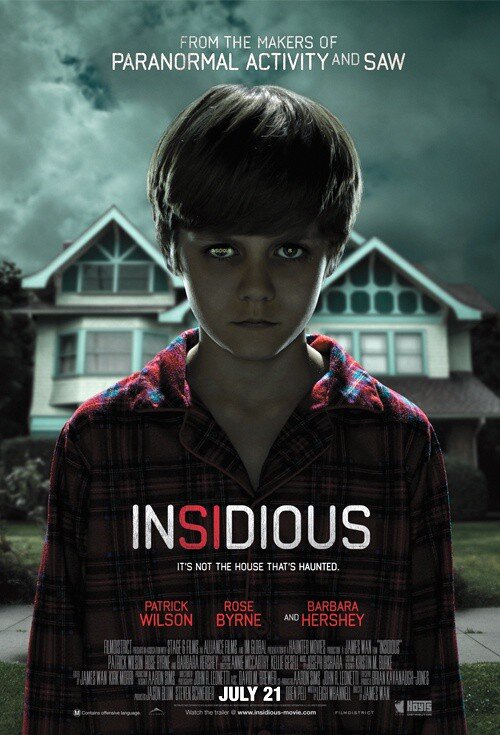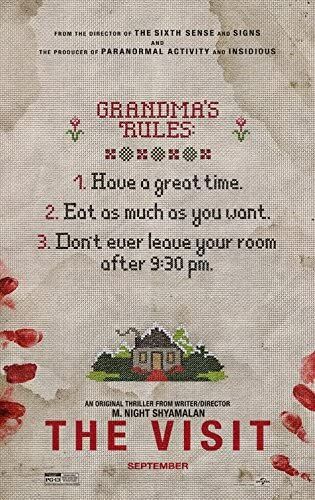The jumpscare; one of the most polarizing yet widely used tropes in the horror genre since Mark Robson’s clever editing work in Jacques Tourneur’s 1942 chiller Cat People. Some will tell you that jumpscares are cheap tactics to manipulate the audience into finding something more scary than it really is, while others insist that if they don’t jump out of their seats at least once then a film quite simply isn’t scary at all. The truth is that jumpscares are neither good nor bad, like an overly aggressive dog the blame can be placed fully on their handler. Here I have personally handpicked and compiled a list of jumpscares from throughout the ages of film, to hopefully weed out the wheat from the chaff in the world of heart-stopping horror moments.
Heavy dramatic music is better for horrific reveals and dramatic moments than to make the audience jump, though some cases have proved it can be effective.
Smile (2022)
Smile is a nightmarish slow-burn horror film comparable to the likes of It Follows (2014) and They Look Like People (2015), with plenty of creepy images and a pervasive sense of building dread throughout its entire runtime. Therapist Dr. Rose Cotter begins experiencing a terrifying phenomenon following a patient’s apparent suicide, and must figure out what smiling, shapeshifting thing is stalking her before it is too late. Unfortunately, just about every frame that could be considered chilling in Smile was shown proudly in its trailer, making the film itself feel like an extended rehash and forcing it to rely on a few jumpscares to keep the wider audience interested. One of these jolts is a scene in which Rose’s sister approaches Rose’s car, knocking on the window. As she does, her head swings violently into view to reveal a hideous smile on her face. The whole thing happens so quickly and the grotesque appearance of the long, swinging neck and demented grin make this a hugely effective scare, even if it was also sadly shown in the trailer.
Insidious (2010)

This one got me good back in 2010, and I still remember jumping clean out of my seat at a couple of points. Of course I was more impressional back then and I’m not sure it would have the same effect nowadays, though I would consider Insidious to be a chillingly atmospheric and intensely creepy horror film nonetheless. Many would probably consider the best jumpscare here to be the appearance of the red-faced demon behind Patrick Wilson’s character, though there was another scene that sticks with me far more. Somewhere in the madness of the first real night of haunting, Renai (played by Rose Byrne) runs into her baby’s room to see a figure standing over the cot. Because this happens in the midst of so much panic, and because Rose Byrne’s reaction through one unbroken camera shot is so convincing, I would place this as one of the more spine-chilling jumpscares James Wan has to offer.
The Visit (2015)

Despite being one of M. Night Shyamalan’s later works, The Visit actually utilises its found-footage presentation well for the most part, offering a group of charismatic and interesting characters and plenty of passable chills, not to mention an ending that calls back to the director’s earlier, more widely regarded films. While I enjoyed a lot of The Visit, we are here to talk about the jumpscares of the matter, which sadly I liked a lot less. One stand-out scene is when the kids are crawling under their grandparent’s house and end up hiding from their snarling ‘grandmother’ as it crawls around looking for them. This may have been a creepy scene if not for the incessant and inhuman screeching and snarling coming from her. These sounds have no bearing on the story and are seemingly there to give the audience a little jolt, like an editing afterthought when it was realised the scene simply wasn’t that scary.
Hereditary (2018)

Ari Aster’s breakout directorial debut Hereditary is a uniquely nasty look at classic haunting tropes, one that shocked audiences with its blend of supernatural chills and pitch-black family drama. The scare I’m choosing to focus on from this particular nightmare is a good case for the argument that quiet jumpscares can work better. Things are already tense as Charlie (Millie Shapiro) struggles through her closing airways and when she tries for air, a small thud is all that’s needed to let us know that the worst has happened. You might not have initially jumped at this one, hell, you might not have even caught it the first time around, but once the realization sets in of what happens when Charlie sticks her head out of the car window, we are left in the same state of silent shock her unfortunate brother Peter (Alex Wolff) is in. Phenomenal acting and truly disturbing subject matter mean that this flick is not for the weak of heart.
The Conjuring (2013)

Like any decent ghostly chiller from James Wan, The Conjuring is chock full of dread, atmosphere and a bucketload of jumpscares. As with his other works such as Insidious, Wan likes to turn up the shocks and then keep them coming until the audience is completely worn out from gritting their teeth. Once the tension ramps up we can expect horrors jumping from every shadow, meaning it can be quite hard to pin down a particular jumpscare amongst the madness. That being said, the reveal of the evil entity, Bathsheba, hiding atop the wardrobe has to be one of the better timed and executed scares of James Wan’s career. Her hideous, yet not over-the-top, appearance flashing so suddenly gives such a threatening air that our fight-or-flight sense begins to tingle at the very sight of her. Couple that with the knowledge that she sacrificed her own child just to get one over on God and you have one truly unsettling antagonist.
Signs (2002)

I’ve already picked on one of Shyamalan’s later works so why not go back and have a look at one of his more worthy creations? Signs stars Mel Gibson and Joaquin Phoenix and could to this day be the scariest sci-fi horror extraterrestrial invasion film in history. This is chiefly due to the thick sense of foreboding that builds over the film’s first couple of acts, before panic ensues and the family hope their preparations weren’t in vain. The scares work here because Shyamalan keeps things quiet for the most part. One standout moment is when Merrill Hess (Phoenix) is watching shaky news footage of an alleged ‘sighting’ at a child’s birthday party. The shot of a backyard alley is held just long enough to put viewers on edge before an alien walks brazenly out and swaggers across to the other side. At this point in the film we don’t know what to expect from these creatures, so when a vaguely sinister humanoid walks out the effect is a confusing and hair-raising jolt. Every little glimpse of a leg or hand of the creatures thus far has been leading to an almost casual reveal, and Phoenix’s reaction illustrates the significance of the event perfectly.
Sinister (2012)

Sinister is a moody and atmospheric horror directed by Scott Derrickson and starring Ethan Hawke, which utilises a home-movie effect through some of its sequences that can be considered some of the creepiest scenes in modern horror. When author Ellsion Oswalt (Hawke) finds a stack of super 8 footage depicting the gruesome murders of several families, he must decipher the connections between them before the malicious entity residing in the footage finds him. I won’t spoil too much, though I’ll say that one of these tapes has one of the more unexpected and gut-dropping jumpscares I’ve personally come across. While Sinister’s third act doesn’t quite live up to the dread built in the first two, it’s still a worthy modern horror flick in many regards and should be watched at least once.
Lights Out (short) (2013)
For this pick I’m giving a shout out to one of the most harrowing short films that ever graced the internet. It was later adapted into a great feature film of the same name, though I still consider the rawness and simplicity of the original Lights Out short to be far superior for a quick scare. Clocking at around three minutes, Lights Out features no dialogue and very minimal sound effects with no excessive increases in volume. When our lead turns out the light and sees the sinister figure at the end of the hall, we see it as she does, with no obnoxious instrumentation or erratic camera editing. As she starts to curiously turn the light on and off , the figure only appearing in the dark, we scream internally to just leave the thing on and get out of the place. The 2016 feature film definitely took things further in every possible way, and happens to be a very competently horrifying film in the process, though something about the short will always reign supreme. Watch the Light Our Horror short below.
Barbarian (2022)

Barbarian is an absolute enigma of a film and is best enjoyed with absolutely no prior knowledge going into it. Let’s just say that the first act in no way hints at the insane length the story goes to, and the first actual reveal of where things are going is downright horrifying. Featuring little to no sound, this particular scene uses a quick and horrifying visual followed by some brutal violence that are both heart-stopping in their abruptness and such a curveball in terms of story that viewers feel completely and suitably helpless.
The Ring (2002)

Gore Verbinski’s 2002 remake of the Japanese chiller Ringu, The Ring, was one of the first horror films I remember seeing, and I still remember the nightmares, the fear of TV static, and the absolute hatred of little girls with long black hair. There’s plenty to be scared of in what I would consider one of the best horror remakes around, though one scene disturbed my young mind beyond belief. Following an account of a young girl’s horrifying death, we are greeted to a quick shot of the victim crouched in a cupboard, her face twisted and warped beyond recognition. The image is so jarring and unexpected that the audience is put in a state of alert apprehension, and although I am biased I would consider it one of the best scares on this list.
Joe first knew he wanted to write in year six after plaguing his teacher’s dreams with a harrowing story of World War prisoners and an insidious ‘book of the dead’. Clearly infatuated with horror, and wearing his influences on his sleeve, he dabbled in some smaller pieces before starting work on his condensed sci-fi epic, System Reset in 2013.Once this was published he began work on many smaller horror stories and poems in bid to harness and connect with his own fears and passions and build on his craft.
Joe is obsessed with atmosphere and aesthetic, big concepts and even bigger senses of scale, feeding on cosmic horror of the deep sea and vastness of space and the emotions these can invoke. His main fixes within the dark arts include horror films, extreme metal music and the bleakest of poetry and science fiction literature.
He holds a deep respect for plot, creative flow and the context of art, and hopes to forge deeper connections between them around filmmakers dabbling in the dark and macabre.
